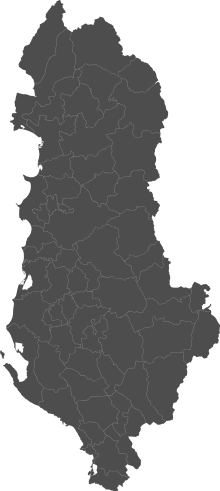Elbasan
Elbasan (Albanian: Elbasan or DEF Elbasani) is a city and a municipality in Elbasan County, central Albania. The fourth largest city in Albania, it is located on the Shkumbin River in the District of Elbasan and the County of Elbasan. The present municipality was formed at the 2015 local government reform by the merger of the former municipalities Bradashesh, Elbasan, Funarë, Gjergjan, Gjinar, Gracen, Labinot-Fushë, Labinot-Mal, Papër, Shirgjan, Shushicë, Tregan and Zavalinë, that became municipal units. The seat of the municipality is the city Elbasan.[1] The total population is 141,714 (2011 census),[2] in a total area of 872.61 km2.[3] The population of the former municipality at the 2011 census was 78,703.[2] The Albanian name is derived from the Ottoman Turkish il-basan ("the fortress").[4]
Elbasan | |
|---|---|
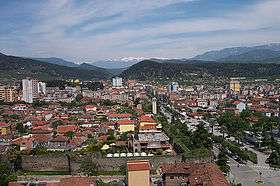  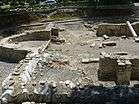  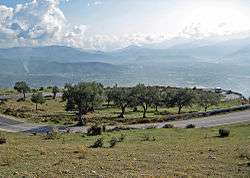 Clockwise from top: Panorama over the city, Ancient walls of the Castle, Ruins of the Basilica (Bezistani), Skampa Theater (Elbasan), Olive trees along the scenic Krraba Pass | |
 Emblem | |
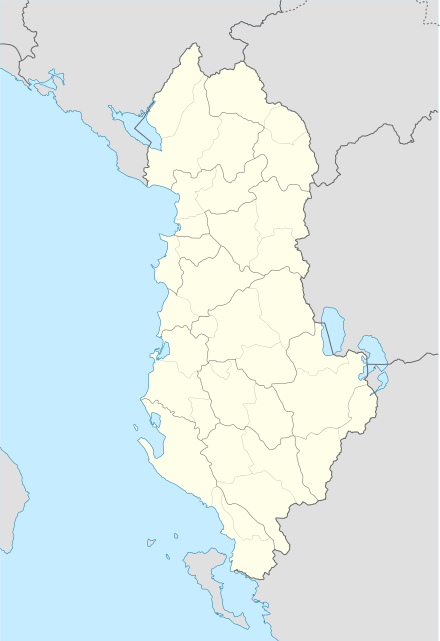 Elbasan | |
| Coordinates: 41°06′40″N 20°04′50″E | |
| Country | |
| County | Elbasan |
| Government | |
| • Mayor | Gledian Llatja (PS) |
| Area | |
| • Municipality | 872.61 km2 (336.92 sq mi) |
| • Municipal unit | 12.90 km2 (4.98 sq mi) |
| Elevation | 150 m (490 ft) |
| Population (2015) | |
| • Municipality | 141,714 |
| • Municipality density | 160/km2 (420/sq mi) |
| • Municipal unit | 120,703 |
| • Municipal unit density | 9,400/km2 (24,000/sq mi) |
| Demonym(s) | Elbasanas/e, Elbasanlli/e |
| Time zone | UTC+1 (CET) |
| • Summer (DST) | UTC+2 (CEST) |
| Postal Code | 3001-3006 |
| Area Code | (0)54 |
| Vehicle registration | EL |
| Website | Official Website |
History
Ancient and early Byzantine periods
In August 2010 archaeologists discovered two Illyrian graves near the walls of the castle of Elbasan.[5]
In the second century BC, a trading post called Mansio Scampa near the site of modern Elbasan developed close to a junction of two branches of an important Roman road, the Via Egnatia, which connected the Adriatic coast with Byzantium. It was one of the most important routes of the Roman Empire. By the third or fourth century AD, this place had grown into a real city protected by a substantial Roman fortress with towers; the fort covered around 300 square meters.[6] This city appears on late antique itineraries like the Tabula Peutingeriana and Itinerarium Burdigalense as Scampis or Hiscampis.[7]
It took part in the spread of Christianity along the Via, and had a bishop, cathedral and basilicas as early as the fifth century. As a town in a wide river valley it was vulnerable to attacks once the legions were withdrawn but Emperor Justinian made an effort to improve the fortifications. The city survived attacks by the Bulgars and Ostrogoths and was mentioned in the work of Procopius of Cæsarea.
Ruins of a Paleochristian basilica, built in the 5th or 6th century AD, were found in Bezistan area.
Ottoman period
The site seems to have been abandoned until the Ottoman army built a military camp there, followed by urban reconstruction under Sultan Mehmet II in 1466. Mehmet constructed a massive four-sided castle with a deep moat and three gates. He named it Elbasan, meaning 'conquered country' in Turkish.[8] He had built the castle in order to fight Skanderbeg, due to an ongoing conflict between the Ottomans and Albanians.[9]
It became the seat of Sanjak of Elbasan, a centre of Ottoman urban civilisation over the next 445 years. Although Halil Inalcik explains that the Sanjak of Elbasan was established as soon as the fortress of Elbasan was constructed in 1466, based on Tursun Beg's records there is a possibility that Elbasan initially was part of the Sanjak of Ohrid.[10] In 1467 many Christians from Skopje, Ohrid, Serres and Kastoria were forcibly deported to Elbasan.[11] In the late 17th century, the Ottoman traveler Evliya Çelebi passed through Elbasan and noted that "all the inhabitants speak Albanian" having knowledge of Turkish with Muslim clergy being literate in Persian, while merchants also used the Greek and "Frankish" languages.[12] By the end of the 17th century it had 2,000 inhabitants. The fortress was dismantled by Reshit Pasha in 1832. In 1864, the Sanjak of Elbasan became a part of Monastir Vilayet. In the late nineteenth century, Elbasan was inhabited by 3,000 Muslim families and 280 Orthodox Christian families, of which 100 were old Orthodox Albanian families living in the old Christian neighbourhood within the fortress and 180 Aromanian families residing in the St. Nicholas neighbourhood on the edge of town.[13] At the beginning of the 20th century it was estimated that 15,000 people lived in Elbasan.[14]
In 1909, after the Young Turks revolution in Istanbul, an Albanian National Congress was held in Elbasan to study educational and cultural questions. The delegates, all from central and southern Albania, endorsed the decision of the Congress of Monastir, which was held in Monastir (modern Bitola, North Macedonia) to use the Latin alphabet rather than the Arabic script in written Albanian. In Elbasan there were living Albanians, Turkish, Aromunian and Sephardic Jews.
Before the Second World War, Elbasan was a city with a mixture of eastern and medieval buildings, narrow cobbled streets and a large bazaar. There was a clearly defined Muslim settlement within the castle walls, a Vlach district on the outskirts of the city and several fine mosques and Islamic buildings. At the time the population was about 15,000 people.
Independence of Albania
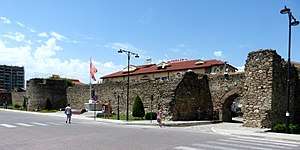
The very first teachers' training college in Albania, the Shkolla Normale e Elbasanit, was established in Elbasan. During First Balkan War, it was occupied by Serbian troops on 29 November 1912. They withdrew from Elbasan on 25 October 1913 due to United Kingdom and Austria Hungary's ultimatum.
The Muslim majority of Elbasan opposed the installation of Prince Wied in 1914. Elbasan was occupied successively by Serbs, Bulgarians, Austrians and Italians between 1915 and 1918. The Bulgarian army occupied Elbasan on January 29, 1916, during Bulgarian occupation of Albania[15] In March 1916 the army of Austria-Hungary took over control of Elbasan [16] From June 1916 to March 1917 Stanislav Kostka Neumann fought with the Austrian army there and called his war memoirs about the occupation in Elbasan.[17] Industrial development began in the Zogist period when tobacco and alcohol factories were established.
The city was also noted for its good public buildings, advanced educational provisions, public gardens and timber-built shops. There was much wartime damage, which was followed by an intensive programme of industrial development in the Communist period that boosted the city to around 75,000 inhabitants. The culmination of this process was the construction of the huge Steel of the Party (Albanian: Celiku i Partise) metallurgical complex outside the city, in the Shkumbini valley, built with Chinese assistance in the 1970s. It was emphatically called "The Second National Liberation of Albanian" by Enver Hoxha. The cost of the complex in environmental impact was high for the Shkumbin valley.[18]
Elbasan Railway Station was opened in 1950.
In 2014, the Albanian government reconstructed former Ruzhdi Bizhuta Stadium. The renovated Elbasan Arena became the home stadium of the Albanian national football team and Albania's de facto stadium meeting FIFA's criteria.
Culture and religion
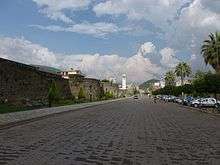
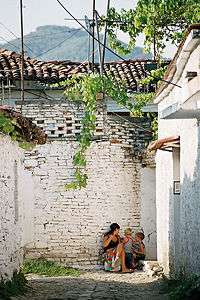
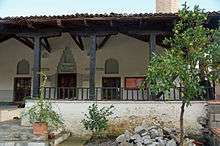
Elbasan has been occupied by several different groups, including the Serbs, Bulgarians, Austrians and Italians. Elbasan remained a center of Islam in Albania even after the Ottoman occupation. After the 1908 Congress of Monastir (in modern Bitola, North Macedonia) decided to use the Latin alphabet for the written Albanian language, Muslim clerics influenced by the Young Turks held various demonstrations in favor of the Arabic script in Elbasan.
In the middle of the city is found the Saint Mary Orthodox Church. The church was built in 1830 on the foundations of an older church, which had partially burned in 1819. Paintings and frescoes of Onufri, restored by David Selenicasi and Kostadin Shelcani can still be seen. The church has been an important religious and cultural center for the Albanian language. Teodor Haxhifilipi, Kostandin Kristoforidhi, and Aleksandër Xhuvani have served in the church. They are the authors of translations into Albanian of many psalms. The church building served as the first Albanian school of Elbasan in modern times, which opened in 1909.[19]
Other orthodox churches in the Elbasan District include the Mameli church (built in the 17th century), the Saint Nicholas church (Albanian: Shen Kolli) in Shelcan (built in 1554), the Saint Nicholas church in Valesh (built in 1604), the Saints Cosmas and Damian church in Sterstan (built in the 18th century), the Saint Michael (Albanian: Shen Mehilli) church in Shalës (built in the 17th century), the Saint Mary church in Dragot (built in the 18th century), the Saint Nicholas church of Elbasan (17th century), and the Elbasan Saint Athanasius church of Elbasan (built in 1554).
About 7 km away from Elbasan there is an old monastery and orthodox church where notably Saint Jovan Vladimir was buried until 1995 when his remains were transferred to the Orthodox Cathedral in Tirana, being brought back to the monastery only for his feast days.[20]
Elbasan is home to the National Autocephalous Albanian Church (Albanian: Kisha Autoqefale Kombetare), a relatively new Orthodox Autocephalous church that split from the Albanian Orthodox Church in 1995. Father Nikolle Marku is the leader of the new denomination.[21]
Elbasan is also home to a Catholic church.
Elbasan has four museums:[22]
- Ethnographic Museum (1982) held in an 18th-century building
- “Kostandin Kristoforidhi” house (started as a museum in 1978)
- Shkolla Normale Museum
- War Museum
Elbasan is home to the Summer Day festivities, a pagan feast celebrating the end of winter and the coming of summer. Ballokume, cookies made from butter and corn wheat, is the traditional dessert served in this day. Since 2004, it has become a national holiday being celebrated nationwide, in all Albania.
Demographics
In recent years Elbasan, like the rest of Albania, has had to deal not only with local pollution, but also with what environmentalists call "imported pollution", because of the waste imported from abroad for the recycling process in private companies.[18]
Economy
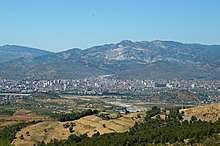
Industrial development began during the Zog regime with the production of tobacco and alcoholic beverages, and culminated during the communist regime. The city gained prominence after the Chinese built a steel mill in 1974. One travel writer relayed from conversation that during the communist regime, most everyone in the country seemed to have a gun, likely manufactured by this Chinese-financed factory in Elbasan, although the country did not seem to have tractors, plows, or sewing machines.[23] There were also other industries operating in the city during the communist regime.
The city was a hub for heavy industry during the communist regime, mostly metallurgic and metal processing factories. All these industries caused big pollution and Elbasan is considered today to be one of the most polluted cities of Albania.
Climate
| Climate data for Elbasan | |||||||||||||
|---|---|---|---|---|---|---|---|---|---|---|---|---|---|
| Month | Jan | Feb | Mar | Apr | May | Jun | Jul | Aug | Sep | Oct | Nov | Dec | Year |
| Average high °C (°F) | 9.5 (49.1) |
11.1 (52.0) |
14.1 (57.4) |
18.0 (64.4) |
22.7 (72.9) |
27.1 (80.8) |
29.6 (85.3) |
29.6 (85.3) |
25.9 (78.6) |
20.3 (68.5) |
14.9 (58.8) |
10.9 (51.6) |
19.5 (67.1) |
| Daily mean °C (°F) | 5.9 (42.6) |
7.1 (44.8) |
9.7 (49.5) |
13.2 (55.8) |
17.6 (63.7) |
21.6 (70.9) |
23.7 (74.7) |
23.7 (74.7) |
20.3 (68.5) |
15.6 (60.1) |
11.1 (52.0) |
7.4 (45.3) |
14.7 (58.5) |
| Average low °C (°F) | 2.4 (36.3) |
3.6 (38.5) |
5.4 (41.7) |
8.5 (47.3) |
12.5 (54.5) |
16.1 (61.0) |
17.9 (64.2) |
17.8 (64.0) |
14.7 (58.5) |
10.9 (51.6) |
7.4 (45.3) |
4.0 (39.2) |
10.1 (50.2) |
| Average precipitation mm (inches) | 124 (4.9) |
113 (4.4) |
92 (3.6) |
84 (3.3) |
82 (3.2) |
52 (2.0) |
34 (1.3) |
38 (1.5) |
65 (2.6) |
101 (4.0) |
148 (5.8) |
133 (5.2) |
1,066 (41.8) |
| Source: [24] | |||||||||||||
Notable people
- Sedefkar Mehmed Agha[25] – or Sedefqar Mehmeti of Elbasan, architect of the Sultan Ahmed Mosque (the "Blue Mosque") in Istanbul.
Politics
- Shefqet Vërlaci – Albanian politician.
- Ibrahim Biçakçiu – Albanian landowner, Axis collaborator and Prime Minister of Albania
- Aqif Pasha Elbasani – Albanian political figure
- Lef Nosi – Albanian politician, scholar and patriot
- Teki Biçoku – Albanian geologist and former member and president of the Academy of Sciences of Albania.
- Qemal Karaosmani – He served as General Secretary of the Provisional Government of Albania
- Thoma Deliana – Albanian politician of Communist Albania
- Sokrat Dodbiba – Albanian economist and politician who served as Minister of Finance of Albania during 1943–44
- Pirro Dodbiba – Albanian politician of the Albanian Party of Labour (PPSh).
- Shefqet Daiu – Signatories of the Albanian Declaration of Independence
- Mahir Domi – Albanian linguist, professor, and academic
- Shefqet Stringa – Banking pioneer in Albania
Military
- Abdullah Pashe Taushani – Member of the Ali Pasha Tepelena's Supreme Council of the Armed Forces
Cinema
- Eva Murati – Albanian actress and TV host
Arts and entertainment
- Saimir Pirgu – Albanian international opera singer
- Miriam Cani – Albanian singer-songwriter and television host
Models
Sports
- Armando Sadiku – Albanian professional footballer who plays as a forward for Levante in La Liga and the Albania national team
- Elton Basriu – Albanian professional footballer
Media
- Kostandin Kristoforidhi – Albanian translator and scholar
- Fatos Kongoli – Recently become one of the most forceful and convincing representatives of contemporary Albanian prose
- Klara Buda – Albanian journalist and writer
- Luljeta Lleshanaku – Albanian poet
- Dhimitër Shuteriqi – Albanian scholar, literary historian, and writer.
- Iliriana Sulkuqi – Award-winning Albanian poet and journalist
Religious
- Visarion Xhuvani – Primate of the Orthodox Autocephalous Church of Albania from 1929 to 1937
International relations
Elbasan is twinned with:
See also
- Elbasan script
- History of Albania
- List of mayors of Elbasan
- Shebenik-Jabllanice National Park
- Clouds of Smoke (documentary film)
Notes
- Kosovo is the subject of a territorial dispute between the Republic of Kosovo and the Republic of Serbia. The Republic of Kosovo unilaterally declared independence on 17 February 2008, but Serbia continues to claim it as part of its own sovereign territory. The two governments began to normalise relations in 2013, as part of the 2013 Brussels Agreement. Kosovo is currently recognized as an independent state by 97 out of the 193 United Nations member states. In total, 112 UN member states recognized Kosovo at some point, of which 15 later withdrew their recognition.
References
- "Law nr. 115/2014" (PDF). Archived from the original (PDF) on 2015-09-24. Retrieved 2015-06-03.
- "Population and housing census - Elbasan 2011" (PDF). INSTAT. Retrieved 2019-09-25.
- "Correspondence table LAU – NUTS 2016, EU-28 and EFTA / available Candidate Countries" (XLS). Eurostat. Retrieved 2019-09-25.
- Robert Elsie: Historical dictionary of Albania. Books.google.gr. 2010-03-19. ISBN 9780810873803. Retrieved 2013-08-10.
- Popja, Fatmir. "Elbasan, zbulohen dy varre ilire në muret e kalasë". Archived from the original on 12 July 2012. Retrieved 9 August 2010.
- Gloyer, Gillian (2012). Albania. Chalfont St Peter: Bradt Travel Guides. p. 107. ISBN 9781841623870. Retrieved 20 October 2013.
mansio scampa.
- Hammond, N.G.L. (1974). "The Western Part of the via Egnatia". The Journal of Roman Studies. Society for the Promotion of Roman Studies. 64: 188. doi:10.2307/299268. JSTOR 299268.
- http://www.blue-albania.com/GeneralInfo14-ELBASANI.htm
- Inalcik, Halil (1989). "The Ottoman Turks and the Crusades, 1451–1522". In Hazard, Harry; Zacour, Norman (eds.). A History of the Crusades: The Impact of the Crusades on Europe. University of Wisconsin Press. p. 327. ISBN 9780299107444.CS1 maint: ref=harv (link)
- Kiel, Machiel (1990), Ottoman architecture in Albania, 1385-1912, Istanbul: Research Centre for Islamic History, Art and Culture, p. 39, ISBN 978-92-9063-330-3, retrieved 9 January 2012,
...states that Elbasan became a sandjak capital right after 1466 but the usually well informed Tursun Beg noted for 1466: "The sultan attached this fortress of Elbasan to the Sancak of Ohrid and returned to Edirne..."
- Shukarova, Aneta; Mitko B. Panov; Dragi Georgiev; Krste Bitovski; Academician Ivan Katardžiev; Vanche Stojchev; Novica Veljanovski; Todor Chepreganov (2008), Todor Chepreganov (ed.), History of the Macedonian People, Skopje: Institute of National History, p. 133, ISBN 9989-159-24-6, OCLC 276645834, retrieved 26 December 2011,
At the same time or nearly in 1467 the citizens from Skopje, ...were expa-triated to the Albanian city of Konjuh (Elbasan), which was constructedas a fortress to help the fighting against Skender-Bey. ... these Christians from Skopje as Elbasan’s citizens appeared other families from Ohrid, Kastoria and Serres that were compulsorily moved into this city...
- Dankoff, Robert; Elsie, Robert (2000). Evliya Çelebi in Albania and Adjacent Regions: Kossovo, Montenegro, Ohrid. Brill. p. 179. ISBN 9789004116245.CS1 maint: ref=harv (link) "Elbasan... All the people speak Albanian. Most also know good Turkish, and the ulema can read Persian. Greek and Frankish are used by the merchants."
- Koukoudis, Asterios (2003). The Vlachs: Metropolis and Diaspora. Thessaloniki: Zitros Publications. p. 358. ISBN 9789607760869.CS1 maint: ref=harv (link) "while at the end of the nineteenth century there were 3,000 Moslem families and 280 Orthodox Christian families. Of these, about 100 old Albanian-speaking Christian families lived in the old Christian quarter in the fortress, while 180 more prosperous Vlach families lived in the St Nicholas district on the outskirts of the town."
- Raza, Moonis (1906). Geographical Dictionary Of The World In The Early 20th Century. Logos Press. p. 588. ISBN 9788172680114. Retrieved 31 July 2011.
...Pop estimated at 15,000
- Pearson, Owen (2004). Albania and King Zog: independence, republic and monarchy 1908-1939. I.B.Tauris. p. 103. ISBN 978-1-84511-013-0. Retrieved January 11, 2011.
January 29th; ... Bulgarian troops had also crossed Albanian frontier, and Elbassan in central Albania was occupied by a company of the 23rd Bulgarian Infantry Regiment under Captain Serafimov
- Pearson, Owen (2004). Albania and King Zog: independence, republic and monarchy 1908-1939. I.B.Tauris. p. 103. ISBN 978-1-84511-013-0. Retrieved January 11, 2011.
March 18th-20th; Austrian troops took possessions of Elbasan ...
- (in Czech) S.K. Neumann: Elbasan, družstevní nakladatelství "Kniha", knihovna socialistické kultury, svazek III., Praha 1922
- Rukaj, Marjola. "Elbasan, Elbasan, the polluted city". Retrieved 20 October 2013.
- "From the Saint Mary website". Kishaautoqefale.webs.com. Archived from the original on 2012-03-05. Retrieved 2013-08-10.
- Milosavljević, Presbyter Čedomir (September 22, 2007). Св. Јован Владимир (in Serbian). Pravoslavna Crkvena Opština Barska. Archived from the original on January 11, 2008. Retrieved January 3, 2008.
- "Church's official website". Kishaautoqefale.webs.com. Archived from the original on 2012-03-05. Retrieved 2013-08-10.
- "Municipality website". Elbasani.gov.al. Retrieved 2013-08-10.
- Theroux, Paul (1995). The Pillars of Hercules: A Grand Tour of the Mediterranean. New York: Fawcett Columbine. p. 272. ISBN 0449910857.
- "Climate: Elbasan". Climate-Data.org. Retrieved November 21, 2018.
- A history of Ottoman architecture. Thames & Hudson. ISBN 0500274290.
External links
| Wikivoyage has a travel guide for Elbasan. |
| Wikimedia Commons has media related to Elbasan. |
- Official website (in Albanian)
- oraret e Elbasanit, Elbasan Timetables
- Elbasan travel guide
- News about Elbasan (in Albanian)
